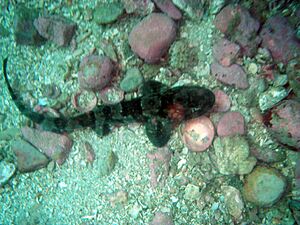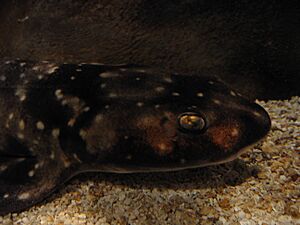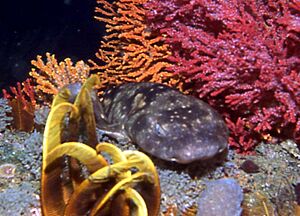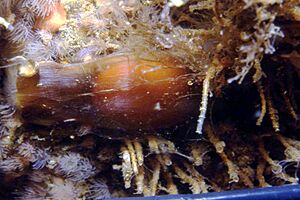Dark shyshark facts for kids
Quick facts for kids Dark shyshark |
|
|---|---|
 |
|
| Conservation status | |
| Scientific classification | |
| Genus: |
Haploblepharus
|
| Species: |
pictus
|
 |
|
| Range of the dark shyshark | |
| Synonyms | |
|
Scyllium pictum Müller & Henle, 1838 |
|
The dark shyshark or pretty happy (Haploblepharus pictus) is a type of catshark. It belongs to the Scyliorhinidae family. This shark lives only in the cool waters off southern Namibia and western South Africa. It stays near the bottom of the ocean in shallow, inshore areas. It especially likes rocky reefs and kelp forests.
This small, strong shark can grow up to 60 cm (24 in) long. It has a wide, flat head with a round snout. A large flap of skin extends from its nostrils to its mouth. Its color can change a lot. It might have orange to blackish stripes or white spots on a light brown to almost black body. When scared, the dark shyshark curls into a ring, covering its eyes with its tail. This is why it's called a "shyshark." It mainly eats small crustaceans, bony fishes, and molluscs. Females lay two egg cases at a time, which hatch after 6 to 10 months. This shark is harmless to humans. It's often caught by people fishing for fun, who sometimes see it as a bother. The International Union for Conservation of Nature (IUCN) says the dark shyshark is of "Least Concern" because it's common and not greatly threatened.
Contents
About the Dark Shyshark's Name
German scientists Johannes Peter Müller and Friedrich Gustav Jakob Henle first described the dark shyshark in 1838. They found five sharks off the Cape of Good Hope. They named it pictum, which means "painted" in Latin, because of its colorful look. Later, this shark was moved into the genus Haploblepharus.
For a long time, people thought the dark shyshark was the same as the puffadder shyshark. But in 1975, scientists showed they were different. It's still often confused with other shyshark species because its colors vary so much. The name "pretty happy" was recently suggested. "Happy" comes from the genus name Haploblepharus. This new name helps avoid confusion with other "shyshark" species. Scientists have studied its mitochondrial DNA. They found that the dark shyshark and the brown shyshark are closely related, like "sister species."
What Does the Dark Shyshark Look Like?
The dark shyshark grows up to 60 cm (24 in) long. Young sharks are thin, but adults are stocky. Its head is short, wide, and flat, with a blunt, round snout. Its nostrils are very large. There are big skin flaps in front of the nostrils that reach the mouth. These flaps hide the openings where water leaves the nose.
Its large, oval eyes have small protective eyelids. There are strong ridges under its eyes. The mouth is short but wide, with grooves at the corners. It has many rows of teeth, each with a long middle point and two smaller points. It has five pairs of gill slits high on its body.
The two dorsal fins (on its back) are almost the same size. They are placed far back on the body. The pectoral and pelvic fins (on its sides) are wide and round. Males have strong claspers, which are used for reproduction. The pelvic and anal fins are about as big as the dorsal fins. The wide caudal fin (tail fin) is about one-fifth of its total length. Its skin is thick and covered in small, arrow-shaped scales called dermal denticles.
The colors of the dark shyshark vary a lot. Its top side can be light brown, reddish, grayish, or almost black. The bottom side is usually white or cream, sometimes with dark spots. It might have 6 to 8 orange, brown, or blackish stripes along its back and tail. These stripes can have black edges. It might also have white spots on or between these stripes.
Where Does the Dark Shyshark Live?
The dark shyshark lives only in the coastal waters of southern Africa. Its range goes from north of Lüderitz in southern Namibia to east of the Storms River mouth in South Africa. It is very common, especially west of Cape Agulhas.
This shark is a bottom-dweller. It lives close to shore, from the area between high and low tides down to 35 m (115 ft) deep. It prefers rocky reefs and kelp forests. However, it probably also swims across sandy areas between good habitats. Since this shark doesn't travel far, there might be different groups of them in different parts of its range.
Dark Shyshark's Life and Habits
The dark shyshark eats many different things. Its main foods are small bottom-dwelling crustaceans, bony fishes, and molluscs. Bigger sharks tend to eat more crustaceans. Sometimes, they also eat polychaete worms and echinoderms (like sea stars). They might accidentally swallow algae too.
Larger sharks, like the broadnose sevengill shark, sometimes eat the dark shyshark. Other big fish and marine mammals might also prey on them. When the dark shyshark feels threatened, it curls into a ring with its tail over its eyes. This behavior makes it harder for predators to swallow. This is where its common names "shyshark" and "doughnut" come from.
Reproduction and Life Cycle
Like other sharks in its group, the dark shyshark lays eggs. Female sharks have one working ovary and two working oviducts (tubes that carry eggs). They don't seem to have a special breeding season. They reproduce all year round.
Females lay two mature eggs at a time, one from each oviduct. The eggs are inside purse-shaped capsules. These capsules are about 5.5 cm (2.2 in) long and 2.5 cm (1 in) wide. Each capsule is plain amber to dark brown. It has thin, coiled tendrils at its four corners. These tendrils help the egg case attach to things on the seafloor.
In nature, eggs usually hatch in 6 to 10 months. The newly hatched sharks are about 10 to 12 cm (3.9 to 4.7 in) long. Both male and female sharks grow at about the same speed. They become adults at around 15 years old. Adult males are usually 40 to 57 cm (16 to 22 in) long. Adult females are 36 to 60 cm (14 to 24 in) long. The dark shyshark can live for up to 25 years.
Dark Shysharks and Humans
The dark shyshark is not dangerous to humans. It is also too small to be important for commercial fishing. Many are caught by people fishing for fun from the shore. These fishers often see the shark as a nuisance and sometimes kill it.
This shark might also be caught by small-scale fishers or in lobster traps and bottom trawl nets. However, this doesn't happen in large numbers. Sometimes, these sharks are kept in aquariums, but people don't fish for them specifically for this purpose.
The International Union for Conservation of Nature (IUCN) lists the dark shyshark as "Least Concern". This means it's not currently at high risk. It is still common and doesn't seem to be greatly threatened by fishing or harm to its habitat. However, because it lives in a small area, an increase in fishing or habitat damage could affect the whole population.





